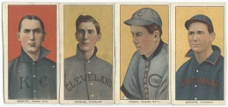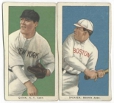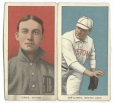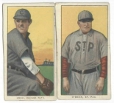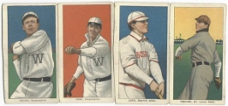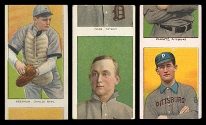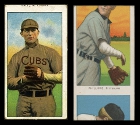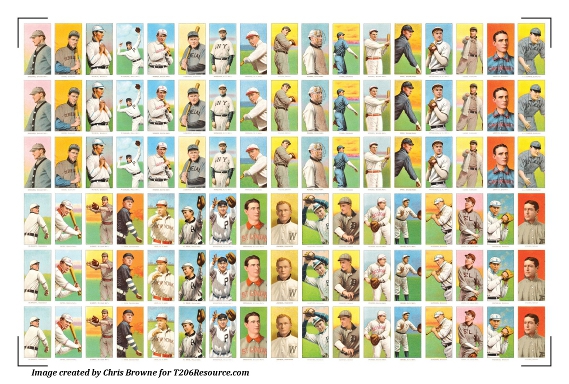Sheet mystique: 34 might be a magic number
by Tim Cathey
April 23, 2012 -- More than 100 years after the T206 set was produced, a remaining mystery is how sheets were configured during the printing process – basically, how many cards were on a sheet? The question could be answered if an uncut sheet were to surface, as others have for sets such as E93 and T212 of the same era. But this has yet to happen. Until an intact T206 sheet does surface, we’re left to ponder the possibilities based on information the set has provided.
We do know that thousands of cards were taken “out the back door” from the American Lithograph Company. This is evidenced by cards such as printers scrap, blank backs and brown Old Mills. These cards were not packaged for distribution and more than likely would have been discarded or destroyed. But they managed to survive and make their way into the collecting world. Surviving examples of these cards show that they were hand cut from sheets. Were these cards cut from sheets prior to or after leaving ALC? The likely answer is both, because we know that some sheets survived for many years intact.
One such story began in 1999, when a gentleman from Florida contacted a well-known dealer with a group of T206s that he wanted to sell. According to a list the man provided, the cards had either Sweet Caporal 350 or blank backs, and all were hand cut. The gentleman explained that his family originally was from the Northeast, and his grandfather was a salesman who had sheets of T206s that he used as samples. In the late teens or early 1920s, several of the sheets were cut into individual cards for the grandson to enjoy as a child. The remaining complete and partial sheets were stored in the attic of the family home. Years later a fire destroyed the attic and all of the sheets. The only cards that survived were those that previously had been cut for the grandson.
During the course of the next three years, the cards were purchased in groups of four or five by the dealer, who in turn immediately sold them to a collector. In total, 57 cards were bought, and all of them ended up in the same collection. During the time of these purchases, the collector mailed to the grandson a letter that included a questionnaire about the cards, uncut sheets and family history. Time passed, but a reply never arrived. In 2002, all communication between the grandson and dealer ceased, and so did the pipeline of cards. According to the original list from the grandson, there were other cards in addition to those that the dealer and collector were able to buy.
The collector who purchased the cards has attempted to recreate the sheets. To date, he has been successful at piecing together cards in groups from two to eight. Though these groups do not give a complete picture of an uncut sheet, they do provide valuable information regarding the vertical placement of subjects. These groups, along with miscut cards or cards with misaligned print runs, show that subjects don’t appear to have been repeated horizontally. These cards also seem to dispel theories that subjects were grouped on sheets by team, pose, or color combinations.
Other miscut cards provide insight to the composition of vertical columns on a sheet. The most common of these are cards with the same name showing on the bottom and top. These show that subjects were repeated in a vertical column at least once. Several cards, including a Cobb and Camnitz, are so severely miscut that the repeating images of the same subject are visible.
The second, less common, group of miscuts are two-name cards. These have the pictured subject’s name on the bottom and another subject’s name on the top. These cards show that there were at least two subjects printed in each vertical column.
Two-name cards are far less common than same-name cards for the following reason:
If, for example, two subjects were printed per vertical column and each subject was repeated three times per column top to bottom, the subjects would be AAABBB. The ratio of places on a sheet that could be miscut with the same name at the top and bottom would be 4:1 (AAABBB, AAABBB, AAABBB, AAABBB).
If each subject was repeated four times per column, the ratio would be 6:1 (AAAABBBB,AAAABBBB, AAAABBBB, AAAABBBB, AAAABBBB, AAAABBBB).
Whether each subject was repeated three or four times per column, there was only one opportunity for a two-name card: AAABBB, AAAABBBB.
The most debated point regarding the sheets’ composition is how many subjects were on each sheet. It’s a difficult question to answer when looking at the set as a whole -- or even in smaller groups by series or back advertisements. Most groups or subsets were printed over extended periods of time with multiple sheet configurations. This convolutes the data, and it results in a total number of subjects not being evenly divisible by the number of subjects on a sheet.
Other groups appear to have been printed with a predetermined number of subjects. This would have required different sheet configurations of which some subjects would be included on multiple sheets and others on only one.
In order to increase the probability of finding the likely number of subjects printed on a sheet, the place to look is not with the groups printed over an extended period of time or with a predetermined number of subjects but rather with the groups that were printed briefly and/or didn’t meet their predetermined number of subjects. These groups offer glimpses into specific moments in time of the T206 set’s production.
The brown Hindu subset is a good example. Advertisements from the era tell us that ALC and American Tobacco Company intended on offering 150 major-league subjects and the 48 southern leagues subjects with brown Hindu backs. But for an unknown reason, the major-league and the southern leagues groups were not fully printed.
Newspaper ads for the southern leagues cards read: “This collection consists of colored lithographs of baseball players in the Southern, South Atlantic, Texas and Virginia Leagues.”
Yet only 34 of the southern leagues subjects were printed; none were from the Texas League. Whatever the reason, the full 48 southern leagues subjects were not printed. Why would the number of subjects be reduced to 34? I think the reason is that 34 was the number of subjects that would fit on a sheet.
Hindu advertisements for the major-league players said that 150 subjects would be available. Again, the number of subjects actually printed fell short of what was advertised. Confirmed subjects show that ALC printed only 102 major-league subjects with this back. 34 subjects x 3 sheets=102.
During printing of the 150 Series, a group of subjects originally printed with a Sweet Caporal 150 Factory No.30 back had the factory number overprinted for distribution out of Factory No.649. The number of subjects that received this overprint is 34. If the number of subjects on a sheet was 34, then ALC took one sheet and overprinted it.
During the production of print group 3, cards were printed for a second time with the Drum back advertisement. The current checklist for this scarce group is thought to be complete with 34 confirmed subjects.
In the late summer or early fall of 1910, ATC produced a set of cards for distribution with their Coupon brand cigarettes. Some people think these cards are part of the T206 set, and others think they are first cousins. Whichever side of the argument one falls on, it’s undeniable that apart from the paper stock used, these cards were produced using the same images and methods of the T206s produced at the same time. Like the other subsets already mentioned, these Coupon cards were printed and offered for a short period of time. The T213-1 set is complete at 68 subjects. 34 subjects x 2 sheets = 68.
The possibility that the total number of subjects on a T206 sheet was 34 is intriguing. Other proposed numbers are divisible by several numbers (4, 6, 12 and 24). When looking at many different subtotals the T206 set provides, these numbers or multiples of them are certain to work in some areas. This is because of how many numbers they can be multiplied or evenly divided by.
With the number 34, the only numbers other than 1 and 34 that it can be divided by evenly are 2 and 17. So if 34 subjects were on a sheet, with no subject duplicated horizontally and each vertical row having two subjects repeated multiple times, a T206 sheet would have looked something like the image below.
This example sheet shows 34 subjects repeated three times each for a total sheet of 102 cards. Given the size of the ALC presses and other known sheets of the time period, it’s quite possible that each image would have been repeated vertically four times for a total of 136 cards per sheet.
There are still many unanswered questions about different aspects of the sheets. We are left to fill in the gaps between facts with the most plausible theories we can, based on what is known. One of the great things about the T206 set is that new information is still being discovered more than 100 years after it ceased production. This leaves even the best theories subject to change. Additional clues to how a sheet was configured seem a certainty, and just maybe an uncut sheet will turn up one day.


